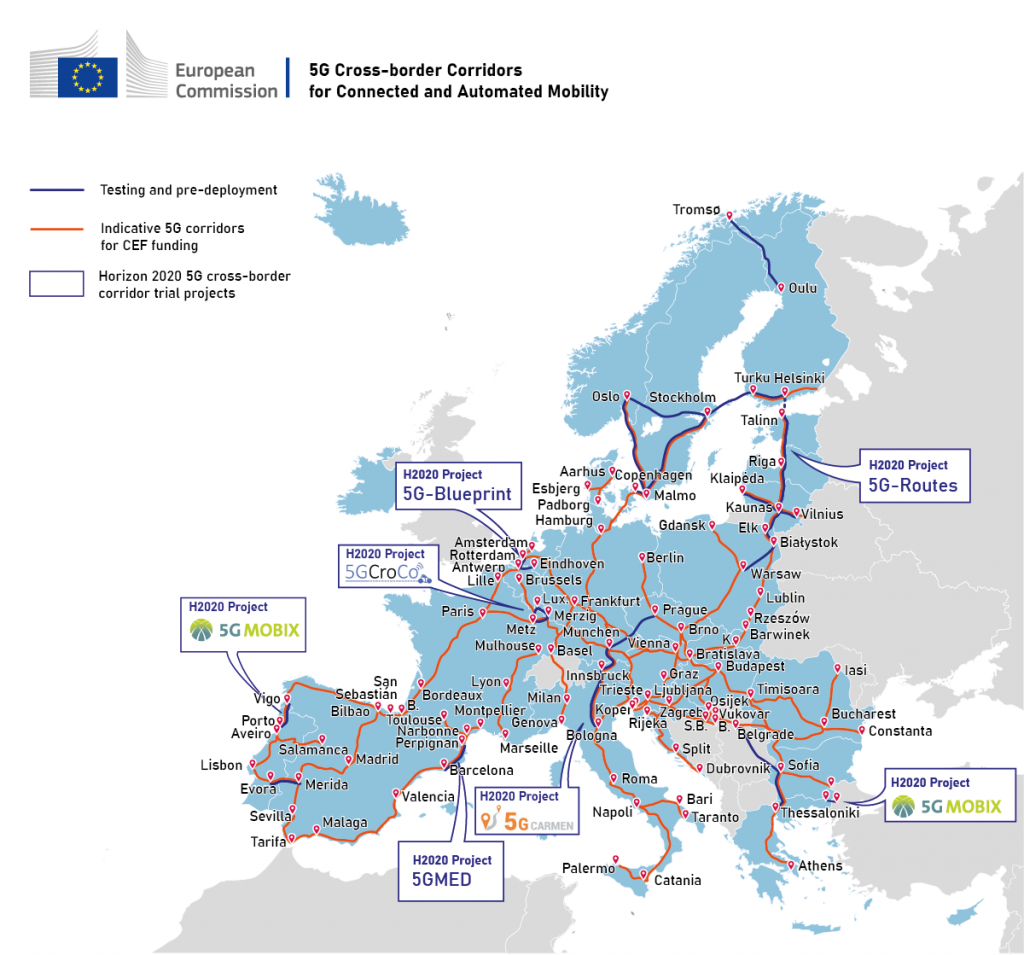

- About us
- Getting Involved
- Plans & Papers
- Events
- European 5G Activities
- Media & News
- Contact
Europe sets 5G Strategic Deployment Agenda for Connected and Automated Mobility
October, 2020
Today, the 5G Public Private Partnership, a joint Commission and European ICT industry initiative, publishes the Strategic Deployment Agenda for the roll-out of 5G corridors. Connected vehicles will be able to access mission-critical information in real time. This will contribute to road safety, to a lower carbon footprint, and to a broad range of digital services for drivers and passengers.
The Commission brought together key stakeholders last week at the European 5G Observatory stakeholder event where Telecom and transport industry experts announced the formal release of the 5G Strategic Deployment Agenda for Connected and Automated Mobility (Click to open document). The 5G Strategic Deployment Agenda presents a common vision for investing in 5G-ecosystems in the field of Connected and Automated Mobility and identifies the key drivers for accelerating infrastructure roll-out. It will serve as a basis for the upcoming privately as well as publicly supported deployment projects in this field with a particular focus on the upcoming Connecting Europe Facility 2 Digital programme.
This agenda is the result of stakeholder engagement under the joint initiative between the European Commission and European ICT industry (the 5G Public-Private Partnership, or the 5G-PPP). It builds upon the initial draft version of the agenda that had been issued in October 2019. The stakeholders involved in this cooperation include representatives from the relevant European industry associations who provide their formal support in the document, as well as the experts of the three 5G corridor trial projects under Horizon 2020.
The Strategic Deployment Agenda can also be down loaded from the 5G-PPP white papers page: https://5g-ppp.eu/white-papers/
Background
The latest findings under the 5G observatory show overall good progress towards the 5G Action Plan targets with the commercial launch of 5G services in more than half of EU countries and further launches expected by the end of 2020. The massive private investments of €1 billion leveraged in 5G trials will be an important enabler for building up 5G ecosystems in Europe’s industrial sectors. However, spectrum assignment is still below 30% and has been delayed in some countries due to the COVID-19 crisis. The stakeholder event identified a number of concrete areas where further actions can contribute to a swift 5G roll-out and adoption in the EU. These range from better coordination in the area of spectrum to easing deployment of 5G infrastructure, as well as raising awareness in industry and the wider society regarding the benefits of 5G.
Europe’s 5G Action Plan sets ambitious objectives for pan-European deployment of 5G connectivity infrastructure along major transport paths by 2025. These “5G corridors” are expected to be a key enabler for connected and automated mobility and for the development of innovative ecosystems around cars and other means of transport.
Three additional 5G corridor trial projects were launched in September 2020. Altogether, they will contribute to the validation of 5G technology solutions for use cases in the field of Connected and Automated Mobility. They will also bring insights on service requirements and network deployment planning in view of the Connecting Europe Facility 2 Digital programme (CEF2 Digital). CEF Digital will provide financial support to the deployment of 5G corridors, with a focus on cross-border sections and other economically challenging areas (see map below).

Next steps
Subsequent versions of the 5G Strategic Deployment Agenda will be coordinated under the European Partnership on Smart and Network Services, which is planned to be launched by the first half of 2021. In addition to the new research programme towards 6G, the partnership will provide strategic guidance for the implementation of CEF Digital and other deployment programmes.
Further planned milestones in relation to the Strategic Deployment Agenda include the identification of potential cooperation models enabling the deployment and use of 5G infrastructures for Connected and Automated Mobility, as well as corridor-specific feasibility studies as part of the exploitation activities under the ongoing 5G corridor trial projects.






Share On